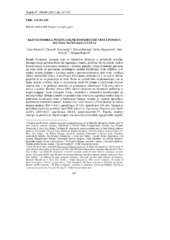Приказ основних података о документу
Razvoj modela potencijalne distribucije vrsta pomoću metoda mašinskog učenja
Development of a species distribution model using machine learning methods
| dc.creator | Pavlović, Lazar | |
| dc.creator | Stojanović, Dejan B. | |
| dc.creator | Kresoja, Milena | |
| dc.creator | Stjepanović, Stefan | |
| dc.creator | Orlović, Saša | |
| dc.creator | Bojović, Mirjana | |
| dc.date.accessioned | 2023-04-07T14:12:49Z | |
| dc.date.available | 2023-04-07T14:12:49Z | |
| dc.date.issued | 2017 | |
| dc.identifier.issn | 0563-9034 | |
| dc.identifier.uri | https://redun.educons.edu.rs/handle/123456789/306 | |
| dc.description.abstract | Klimatske promene koje se intenzivno dešavaju u poslednjih nekoliko decenija imaju globalni efekat na vegetaciju i šumski pokrivač, što dovodi do velikih transformacija u prirodnim resursima i strukturi pejzaža. Uticaj klimatskih promena na vrste često se procenjuje korištenjem modela distribucije vrste (SDMs). Ovi modeli koriste podatke o životnoj sredini i prisustvu/odsustvu neke vrste, utvrđuju njihov međusobni odnos, te na drugim lokacijama pokazuju da li su uslovi sredine pogodni ili ne za postojanje te vrste. Pošto se modeli lako implementiraju, oni se danas koriste u velikoj meri za razmatranje različitih pitanja u istraživanju životne sredine, kao i za pružanje smernica za primenjena istraživanja. Cilj ovog rada je razviti i oceniti Random Forest (RF) model zasnovan na trenutnim podacima o rasprostranjenju šuma evropske bukve, ekoloških i klimatskih karakteristika na teritoriji Srbije. Dobijeni model će poslužiti kao osnova za izgradnju modela koji će predvideti distribucije vrste u budućnosti.Tačnost modela je ispitana upotrebom adekvatnih statističkih metoda. Analiza True Skill Statistic (TSS) ukazuje na veliku tačnost modela (TSS = 0.87, specifičnost =87.81, senzitivnost =99.44). Tačnost je potvrđena analizom površine ispod ROC (Receiver Operating Characteristic) krive (AUC) (AUC=0.97, specifičnost =88.01, senzitivnost=99.27). Takođe, rezultati ukazuju na potrebu za uključivanjem više ekološki relevantnih topografskih varijabli prilikom projektovanja modela distribucije vrsta u odnosu na klimatske promene, naročito za vrste koje su u korelaciji sa topografijom, odnosno visinskom raspodelom. | sr |
| dc.description.abstract | Climate change that has been intensively occurring in the last few decades has a global effect on vegetation and forest cover, leading to major transformations in natural resources and the landscape structure. The impact of climate changes on species is often estimated using a species distribution models (SDMs). These models use environmental data and presence/absence of a species, determine their mutual relationship, in order to show on other locations whether environmental conditions are suitable or not for the existence of this species. Since models are easy to implement, they are now widely used to consider various issues in environmental research, as well as providing guidance for applied research. The aim of this paper is to develop and evaluate the Random Forest (RF) model based on current data on existence of European beech, ecological and climatic characteristics in the territory of Serbia. The model obtained will serve as the basis for building a model that will foresee the distribution of species in the future. The accuracy of the model was tested using adequate statistical methods. The True Skill Statistic (TSS) analysis indicates a high accuracy of the model (TSS = 0.87, specificity = 87.81, sensitivity = 99.44). The accuracy was confirmed by the analysis of the area under the ROC (Receiver Operating Characteristic) curve (AUC) (AUC = 0.97, specificity = 88.01, sensitivity = 99.27). Also, the results pointed to the need to include more environmentally relevant topographic variables when designing a SDM in relation to climate change, especially for species that are correlated with topography. | en |
| dc.publisher | Univerzitet u Novom Sadu - Institut za nizijsko šumarstvo i životnu sredinu, Novi Sad | |
| dc.relation | info:eu-repo/grantAgreement/MESTD/Integrated and Interdisciplinary Research (IIR or III)/43007/RS// | |
| dc.rights | openAccess | |
| dc.rights.uri | https://creativecommons.org/licenses/by/4.0/ | |
| dc.source | Topola | |
| dc.subject | modeli distribucije vrsta | sr |
| dc.subject | mašinsko učenje | sr |
| dc.subject | Evropska bukva | sr |
| dc.subject | BIOMOD2 | sr |
| dc.subject | species distribution models - SDMs | en |
| dc.subject | machine learning | en |
| dc.subject | European beech | en |
| dc.subject | BIOMOD2 | en |
| dc.title | Razvoj modela potencijalne distribucije vrsta pomoću metoda mašinskog učenja | sr |
| dc.title | Development of a species distribution model using machine learning methods | en |
| dc.type | article | |
| dc.rights.license | BY | |
| dc.citation.epage | 175 | |
| dc.citation.issue | 199-200 | |
| dc.citation.other | (199-200): 167-175 | |
| dc.citation.rank | M51 | |
| dc.citation.spage | 167 | |
| dc.identifier.fulltext | http://redun.educons.edu.rs/bitstream/id/122/303.pdf | |
| dc.identifier.rcub | conv_303 | |
| dc.type.version | publishedVersion |

